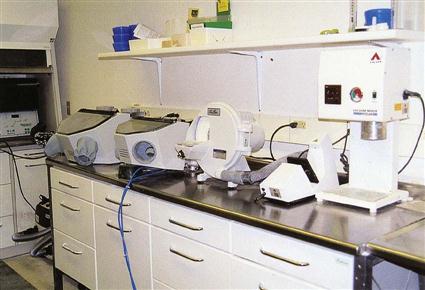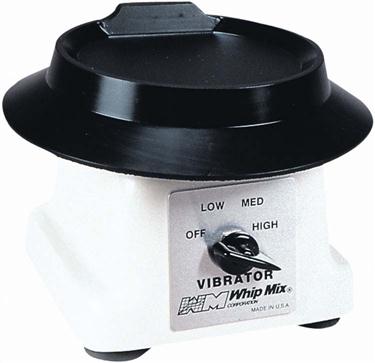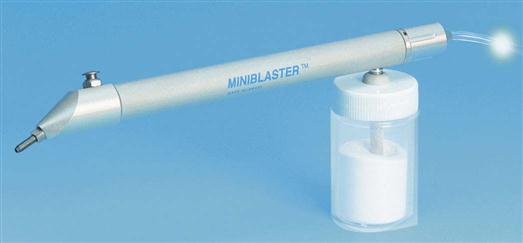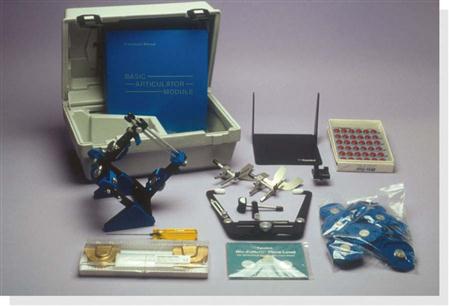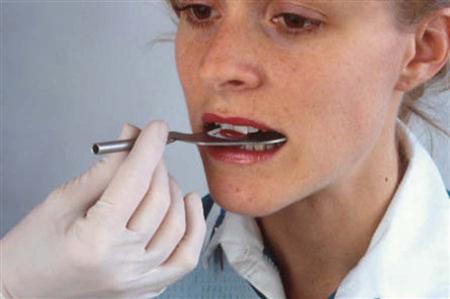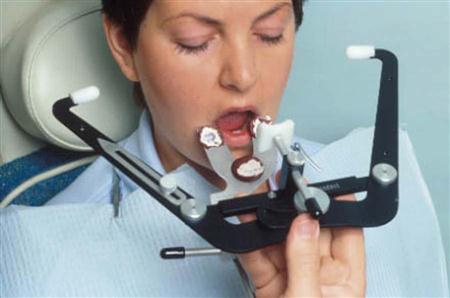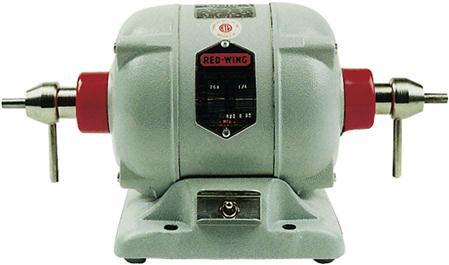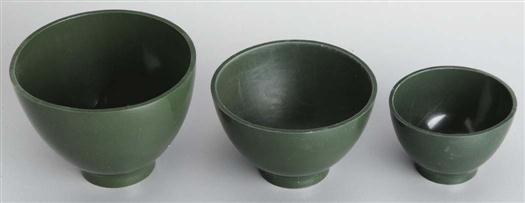Laboratory Materials and Procedures
Learning Outcomes
On completion of this chapter, the student will be able to achieve the following objectives:
• Pronounce, define, and spell the Key Terms.
• Discuss the safety precautions that should be taken in the dental laboratory.
• List the types of equipment found in a dental laboratory and describe their uses.
• Describe the use of the face bow when measuring the centric relationship of the teeth.
• Identify dental models and explain how they are used in dentistry.
• Discuss gypsum products and their role in the making of dental models.
• List the three types of custom impression trays and describe their use in dentistry.
• Identify the types of dental waxes and describe their use in dentistry.
Performance Outcomes
On completion of this chapter, the student will be able to achieve competency standards in the following skills:
• Take a face-bow registration.
• Pour a set of dental models using the inverted-pour method.
• Trim and finish a set of dental models.
• Construct an acrylic resin custom tray.
Electronic Resources
![]() Additional information related to content in Chapter 47 can be found on the companion Evolve Web site.
Additional information related to content in Chapter 47 can be found on the companion Evolve Web site.
• Interactive Dental Office Patient Case Study: Evalena Horton
• Procedure Sequencing Exercises
• WebLinks
![]() and the Multimedia Procedures DVD
and the Multimedia Procedures DVD
Key Terms
Anatomical portion (an-uh-TOM-ik-al) The structural portion of a dental model created from the alginate impression.
Articulator (ar-TIK-yoo-lay-tur) Dental laboratory device that simulates mandibular and temporomandibular joint movement when models of the dental arches are attached to it.
Crystallization (kris-tul-i-ZAY-shun) Chemical process in which crystals form a structure.
Dihydrate (dye-HYE-drayt) Related to gypsum products and indicating two parts of water to one part of calcium sulfate.
Dimensionally (di-MEN-shun-uh-lee) stable Resistant to changes in width, height, and length.
Face bow Portion of articulator used to measure the upper teeth as compared with the temporomandibular joint.
Gypsum (JIP-sum) Mineral used in the formation of plaster of Paris and stone.
Hemihydrate (hem-ee-HYE-drayt) Removal of water to become one-half part water to one part of calcium sulfate, forming the powder product of gypsum.
Homogenous (hoe-MOJ-uh-nus), homogeneous (hoe-moe-JEE-nee-us) Having a uniform quality and consistency throughout.
Lathe (layth) Machine used for cutting or polishing dental appliances.
Model Replica of the maxillary and mandibular arches made from an impression.
Monomer (MON-oe-mur) A molecule that, when combined with other molecules, forms a polymer.
Polymer (POL-i-mur) Compound of many molecules.
Slurry (SLUR-ee) Mixture of gypsum and water used in the finishing of models.
Volatile (VOL-uh-til) Substance that can evaporate easily and is very explosive.
The dental laboratory is a separate area of the dental office (away from the patient treatment area) where the dentist and the clinical staff complete the following procedures:
• Pour up preliminary impressions
• Trim and finish diagnostic models
• Polish provisionals, partial or full dentures, and indirect restorations
Specialty practices, such as pediatric dentistry, orthodontics, and fixed and removable prosthodontics will have a more extensive laboratory because they have more lab work to complete. Having more equipment and greater competence in the laboratory allows the dentist or the private dental laboratory technician to handle larger cases and keep overhead costs to a minimum. If a case cannot be handled in the laboratory, it will be sent to a commercial dental laboratory (Fig. 47-1).
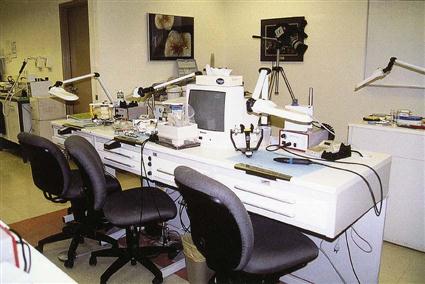
Safety in the Dental Laboratory
When working in the laboratory, you must make safety your first concern. It is essential to follow safety precautions and infection control procedures. Remember, items brought into the laboratory from the treatment room area are contaminated, and exposure control is just as important here as when you are with the patient.
Laboratory Rules
Physical Safety
When working around electrical equipment or items that produce high heat, you must become familiar with the location of the fire extinguisher and with fire escape routes. Keep all equipment in good working order, and always follow the manufacturer’s directions when handling equipment.
Chemical Safety
Dental materials in the laboratory area may include corrosive, toxic, or carcinogenic substances. Take care when handling and using these materials, and take special precautions to avoid coming in direct contact with chemicals that could be inhaled, absorbed, or ingested. (See Chapter 23 on exposure to and protection from hazardous chemicals.)
Biohazards
Biohazards usually are associated with the treatment area and the sterilization center. However, impressions and other items brought into the laboratory can harbor blood and saliva that could be infectious. The laboratory area and contaminated items must be disinfected before and after each use when biohazards are a concern.
Dental Laboratory Equipment
The dental laboratory is equipped with a countertop and cabinets to provide adequate work areas and safe storage for supplies and equipment used in the laboratory (Fig. 47-2).
Wall-mounted bins are used to store bulk supplies of plaster, stone, and investment materials. These bins protect materials from moisture contamination and make it easy to remove gypsum products as needed. After the material has been retrieved, the bin should be re-covered immediately.
Work pans are open plastic containers with identification labels used to hold the laboratory work in progress for an individual patient. Pans may be color-coded to indicate the type of procedure to be performed.
Heat Sources
A heat source is required in the laboratory to heat wax or other materials. A propane or butane torch is used for this purpose. If a gas line has been installed in the laboratory, rubber hosing will be attached to a Bunsen burner and then to the gas outlet. Remember to turn the handle completely on or completely off. Otherwise, gas can escape, thereby creating a very dangerous environment.
Model Trimmer
The model trimmer is a machine that is used to trim stone or plaster models (Fig. 47-3). The model trimmer has an abrasive grinding wheel used to grind away excess plaster or stone. This wheel works more effectively if it is kept clean, which prevents stone or plaster from building up. Models are placed on the work surface and are held in place by firm pressure with the hands or with a holding device that can be attached.
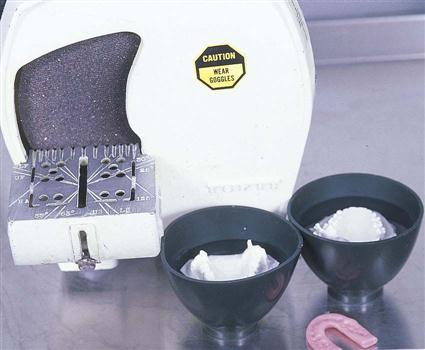
To control the dust level from the cast and to facilitate cutting, a gentle stream of water continuously runs on the wheel when in use. Used water drains directly into a sink equipped with a plaster trap that catches the grindings and prevents them from clogging the drain.
Vacuum Former
A vacuum former is a small electrical appliance used to construct custom trays for bleaching, mouth guards, and positioners for orthodontics (Fig. 47-4). The upper part of the unit is a heating element that warms and softens a sheet of thermoplastic resin. The work surface has holes that allow the vacuum to pull and shape the warmed plastic around the model.
Vibrator
A vibrator is used to remove air from the mix of plaster or stone and to aid in the flow of material when a diagnostic model is poured up (Fig. 47-5). The vibrator has a flat working surface that vibrates the bowl or tray. To help keep the vibrator clean, a disposable cover can be placed on the work surface before it is used. After use, this cover is discarded.
Laboratory Handpiece
A low-speed laboratory handpiece is used for many tasks, such as trimming custom impression trays, adjusting dentures, and polishing provisional and indirect restorations. The laboratory handpiece and burs are discussed further in Chapter 35.
Sandblaster
A sandblaster is a handheld unit that sprays sand at a high rate of speed, creating an etching or pitting on a surface area of metals, porcelain, or acrylic (Fig. 47-6). These elevations in the surface area create added retention through surface roughening. Sandblasting is suitable for the repair of crowns, dentures, and appliances, as well as for the cementation of crowns, bridges, and inlays.
Articulator
An articulator is a mechanical device used in dentistry to hold maxillary and mandibular dental models in a position to aid in reproduction of the mandible in relation to the maxilla. The articulator allows the dentist and the dental laboratory technician to fabricate removable prosthodontic appliances (dentures), fixed prosthodontic restorations (crowns, bridges, inlays, and onlays) and orthodontic appliances (Fig. 47-7). Special records are taken to position the dental models accurately on the articulator.
Face Bow
The face bow is the first step the dentist takes to determine the positional relationship of the maxillary arch to the temporomandibular joints. The centric relation or bite record is a measurement of where the teeth are positioned when the joints are aligned correctly and before the teeth actually come in contact.
In some states, it is legal for the expanded-function dental assistant (EFDA) to perform the technique for taking a face-bow registration. See Procedure 47-1.
Dental Lathe
The dental lathe is used to polish or trim custom trays, provisionals, dentures, and indirect restorations. The lathe is designed with a protective plastic see-through shield that is brought down over the work area. The lathe has revolving threaded extensions from each end of the motor. Attachments such as an abrasive grinding wheel or a rag wheel are placed on these extensions. After each use, these attachments must be sterilized before reuse (Fig. 47-8).
Pumice and other polishing agents are used during polishing. A protective pan behind and under the wheel is used to hold the pumice and catch the spatter.
Specialized Spatulas and Bowls
A few specialized instruments are used frequently in the dental laboratory. As with any instruments, these must be sterilized and stored properly after each use.
Wax Spatulas
A wax spatula is a double-ended instrument used in waxing a pattern, or when one is working with wax for a partial or a full denture. The #7 wax spatula is the spatula that is used most often in the laboratory (Fig. 47-9).
Mixing Spatulas
Several types of mixing spatulas may be found in the laboratory. The type of spatula chosen depends on the strength of the dental material being mixed.
Rubber Bowls
Rubber bowls are used for mixing of alginate in the treatment area and for mixing of stone or plaster in the laboratory setting. Make sure to have an adequate supply of rubber bowls in the office (Fig. 47-10).
Dental Models
Dental models, also referred to as study casts, are accurate three-dimensional reproductions of the teeth and surrounding soft tissues of the patient’s maxillary and mandibular arches (Fig. 47-11). A model is created by using an alginate impression. The alginate impression is taken to the laboratory and then is poured into a gypsum product to create the completed model.
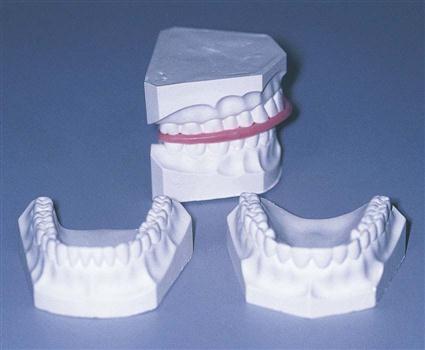
Because these models show a three-dimensional view of conditions, they are a valuable diagnostic tool. The dentist can use these models to study the patient’s mouth from angles that are impossible to reach during the clinical examination. Dental models are used for the following procedures in dentistry:
• Diagnosis for planning a fixed or removable prosthetic device
• Diagnosis of orthodontic treatment
• Visual presentation of dental treatment
• Creation of orthodontic appliances
Gypsum Products
Gypsum products are used extensively in dentistry to make dental models. Many characteristics and properties affect the use of gypsum.
Chemical Properties
G/>
Stay updated, free dental videos. Join our Telegram channel

VIDEdental - Online dental courses


